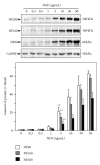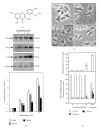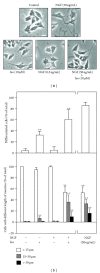Isorhamnetin, A Flavonol Aglycone from Ginkgo biloba L., Induces Neuronal Differentiation of Cultured PC12 Cells: Potentiating the Effect of Nerve Growth Factor
- PMID: 22761636
- PMCID: PMC3385709
- DOI: 10.1155/2012/278273
Isorhamnetin, A Flavonol Aglycone from Ginkgo biloba L., Induces Neuronal Differentiation of Cultured PC12 Cells: Potentiating the Effect of Nerve Growth Factor
Abstract
Flavonoids, a group of compounds mainly derived from vegetables and herbal medicines, share a chemical resemblance to estrogen, and indeed some of which have been used as estrogen substitutes. In searching for possible functions of flavonoids, the neuroprotective effect in brain could lead to novel treatment, or prevention, for neurodegenerative diseases. Here, different subclasses of flavonoids were analyzed for its inductive role in neurite outgrowth of cultured PC12 cells. Amongst the tested flavonoids, a flavonol aglycone, isorhamnetin that was isolated mainly from the leaves of Ginkgo biloba L. showed robust induction in the expression of neurofilament, a protein marker for neurite outgrowth, of cultured PC12 cells. Although isorhamnetin by itself did not show significant inductive effect on neurite outgrowth of cultured PC12 cells, the application of isorhamnetin potentiated the nerve growth factor- (NGF-)induced neurite outgrowth. In parallel, the expression of neurofilaments was markedly increased in the cotreatment of NGF and isorhamnetin in the cultures. The identification of these neurite-promoting flavonoids could be very useful in finding potential drugs, or food supplements, for treating various neurodegenerative diseases, including Alzheimer's disease and depression.
Figures







Similar articles
-
Neurite Outgrowth-Promoting Compounds from the Petals of Paeonia lactiflora in PC12 Cells.Molecules. 2022 Nov 8;27(22):7670. doi: 10.3390/molecules27227670. Molecules. 2022. PMID: 36431771 Free PMC article.
-
Shexiang Baoxin Pill, a Formulated Chinese Herbal Mixture, Induces Neuronal Differentiation of PC12 Cells: A Signaling Triggered by Activation of Protein Kinase A.Front Pharmacol. 2019 Oct 9;10:1130. doi: 10.3389/fphar.2019.01130. eCollection 2019. Front Pharmacol. 2019. PMID: 31649530 Free PMC article.
-
Flavonoids possess neuroprotective effects on cultured pheochromocytoma PC12 cells: a comparison of different flavonoids in activating estrogenic effect and in preventing beta-amyloid-induced cell death.J Agric Food Chem. 2007 Mar 21;55(6):2438-45. doi: 10.1021/jf063299z. Epub 2007 Feb 27. J Agric Food Chem. 2007. PMID: 17323972
-
Kai-Xin-San, a traditional Chinese medicine formula, induces neuronal differentiation of cultured PC12 cells: Modulating neurotransmitter regulation enzymes and potentiating NGF inducing neurite outgrowth.J Ethnopharmacol. 2016 Dec 4;193:272-282. doi: 10.1016/j.jep.2016.08.013. Epub 2016 Aug 12. J Ethnopharmacol. 2016. PMID: 27530376
-
Chemical analysis and quality control of Ginkgo biloba leaves, extracts, and phytopharmaceuticals.J Chromatogr A. 2009 Mar 13;1216(11):2002-32. doi: 10.1016/j.chroma.2009.01.013. Epub 2009 Jan 15. J Chromatogr A. 2009. PMID: 19195661 Review.
Cited by
-
Indication of nerve growth factor binding components from herbal extracts by HerboChip: a platform for drug screening on a chip.Chin Med. 2016 Jul 23;11:34. doi: 10.1186/s13020-016-0107-8. eCollection 2016. Chin Med. 2016. PMID: 27453720 Free PMC article.
-
Flavonoids induce the synthesis and secretion of neurotrophic factors in cultured rat astrocytes: a signaling response mediated by estrogen receptor.Evid Based Complement Alternat Med. 2013;2013:127075. doi: 10.1155/2013/127075. Epub 2013 Jun 25. Evid Based Complement Alternat Med. 2013. PMID: 23878590 Free PMC article.
-
Investigation of Anticonvulsant Potential of Morus alba, Angelica archangelica, Valeriana officinalis, and Passiflora incarnata Extracts: In Vivo and In Silico Studies.Int J Mol Sci. 2025 Jul 3;26(13):6426. doi: 10.3390/ijms26136426. Int J Mol Sci. 2025. PMID: 40650201 Free PMC article.
-
The potential neuroprotective effects of stingless bee honey.Front Aging Neurosci. 2023 Feb 8;14:1048028. doi: 10.3389/fnagi.2022.1048028. eCollection 2022. Front Aging Neurosci. 2023. PMID: 36846103 Free PMC article. Review.
-
Ginkgo biloba flavonoid glycosides in antimicrobial perspective with reference to extraction method.J Tradit Complement Med. 2018 Jan 17;9(1):15-23. doi: 10.1016/j.jtcme.2017.10.003. eCollection 2019 Jan. J Tradit Complement Med. 2018. PMID: 30671362 Free PMC article.
References
-
- Miksicek RJ. Commonly occurring plant flavonoids have estrogenic activity. Molecular Pharmacology. 1993;44(1):37–43. - PubMed
-
- Murkies AL, Wilcox G, Davis SR. Phytoestrogens. Journal of Clinical Endocrinology and Metabolism. 1998;83(2):297–303. - PubMed
-
- Zhu JTT, Choi RCY, Chu GKY, et al. Flavonoids possess neuroprotective effects on cultured pheochromocytoma PC12 cells: a comparison of different flavonoids in activating estrogenic effect and in preventing β-amyloid-induced cell death. Journal of Agricultural and Food Chemistry. 2007;55(6):2438–2445. - PubMed
-
- Choi RCY, Zhu JTT, Leung KW, et al. A flavonol glycoside, isolated from roots of panax notoginseng, reduces amyloid-β-induced neurotoxicity in cultured neurons: signaling transduction and drug development for Alzheimer’s disease. Journal of Alzheimer’s Disease. 2010;19(3):795–811. - PubMed
-
- Zhu JTT, Choi RCY, Xie HQ, et al. Hibifolin, a flavonol glycoside, prevents β-amyloid-induced neurotoxicity in cultured cortical neurons. Neuroscience Letters. 2009;461(2):172–176. - PubMed
LinkOut - more resources
Full Text Sources
Other Literature Sources

